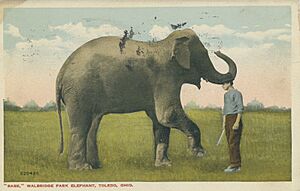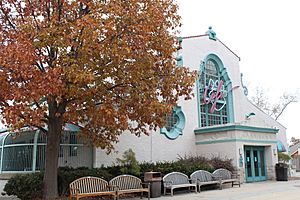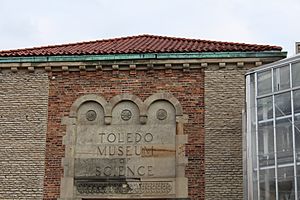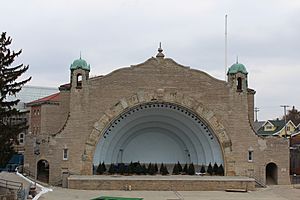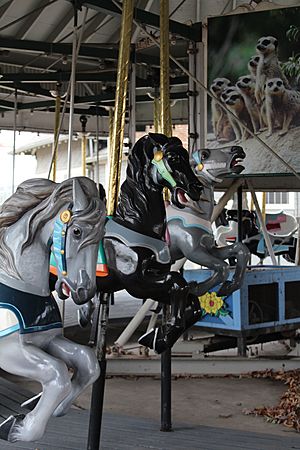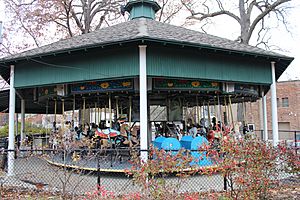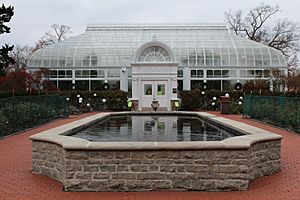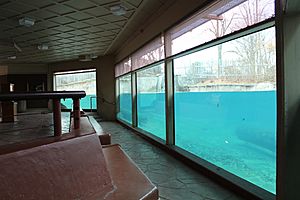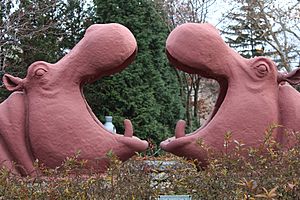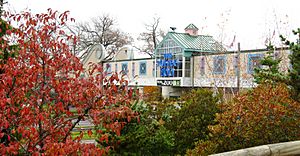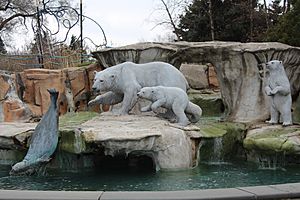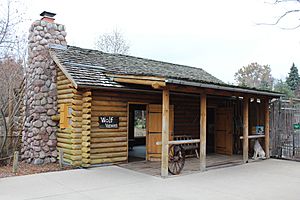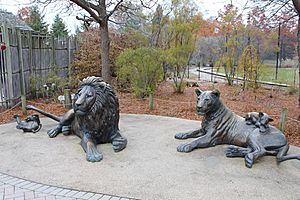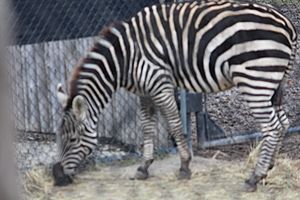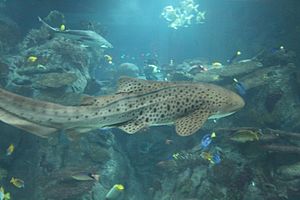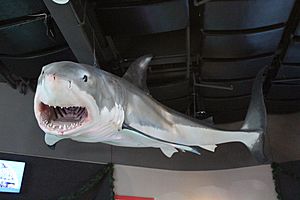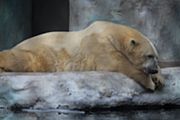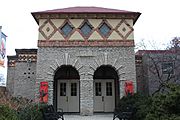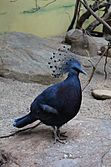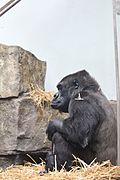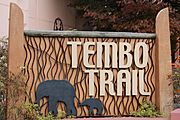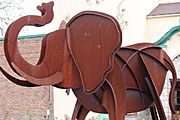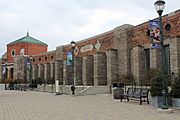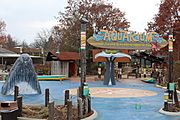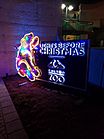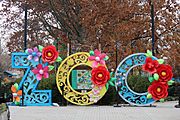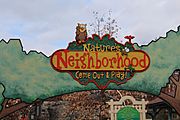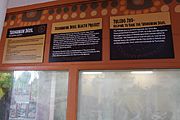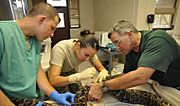- This page was last modified on 17 October 2025, at 10:18. Suggest an edit.
Toledo Zoo & Aquarium facts for kids
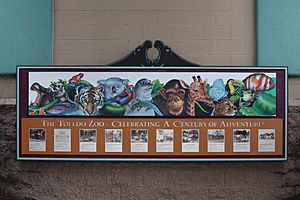 |
|
| Date opened | 1900 |
|---|---|
| Location | Toledo, Ohio, United States |
| Land area | 51 acres (21 ha) on south side |
| Coordinates | 41°37′09″N 83°34′51″W / 41.6191°N 83.5807°W |
| No. of animals | 10,000 + |
| No. of species | 720 |
| Memberships | AZA, WAZA, BFCI |
| Major exhibits | Africa!, Aquarium, Arctic Encounter, Aviary, Maned Wolf, Bald Eagles, The Valley, Nature's Neighborhood, ProMedica Museum of Natural History, Primate Forest, Reptile House, Snow Leopards, Flamingo Key, Tiger Terrace, Ziems Conservatory, Tembo Trail, Penguin Beach, Cassowary Crossing, Galapagos Gardens |
The Toledo Zoo & Aquarium is a famous zoo located in Toledo, Ohio. It is a member of the World Association of Zoos and Aquariums (WAZA). It is also approved by the Association of Zoos and Aquariums (AZA). The Toledo Zoo is known as one of the best zoos in the country. It is home to over 10,000 animals from 720 different kinds of species. The zoo also helps with about 80 programs to save animal species.
Contents
- History of the Toledo Zoo
- Explore the Exhibits
- Africa! Exhibit
- Aquarium Wonders
- Arctic Encounter
- Aviary Birds
- The Rescue Roost
- Cassowary Crossing
- Ziems Conservatory
- Flamingo Key
- Kingdom of the Apes
- ProMedica Museum of Natural History
- Nature's Neighborhood
- Penguin Beach
- Pheasantry
- Primate Forest
- Reptile House
- Tembo Trail
- Tiger Terrace
- Snow Leopards
- Fun Events and Attractions
- Aerial Adventure Course
- African Carousel
- Aquarium Experiences
- Aquarium Adventure Trail
- Feast with the Beasts
- Garden Tours
- The Lights Before Christmas
- Little Boo at the Zoo/Pumpkin Path
- Luminous Nights
- Medical Mutual Dart Frog Dash
- Music Under the Stars
- Nature's Neighborhood
- Safari Railway
- Summer Concert Series
- Tower Ridge
- Wild about Art
- Wine Tasting
- Zoo Brew
- ZootoDo
- Conservation Efforts
- Awards and Recognition
History of the Toledo Zoo
How the Zoo Started: 1900–1920
The Toledo Zoo began in 1900 with a simple gift. A woodchuck was donated to Walbridge Park. By the end of its first year, the zoo had 39 animals. Most of these animals were also donated. The park was not ready for so many animals. They had to use temporary homes like ravines and boxes.
In 1901, a fire almost destroyed all the animals' winter homes. Because of this, the zoo built its first brick building in 1907. This building was called the Lion House. In the early years, animals often came from donations or circuses. Sometimes, animals would even escape because their homes were not strong enough.
In 1913, the Toledo Zoological Society (TZS) was created. This group helped the zoo grow. William H. Roemer was its first president. By 1916, the zoo had 471 animals. In 1922, Percy Jones, the TZS president, created a new job: Zoo Director. Frank Skeldon was the first person to hold this important role. Jones and Skeldon worked hard to make the zoo famous across the country.
Building Up the Zoo: 1920–1929
The zoo's first big building plan was inspired by Spanish architecture. This style came from the city's namesake, Toledo, Spain. By 1924, the first building of this plan was finished. It was the Elephant House.
To keep the zoo funded, Percy Jones made a deal with the City of Toledo. This allowed the zoo to be run like the Bronx Zoo. In 1926, the Toledo Zoo became a mix of public and private ownership. This meant the city helped with money, but the TZS managed the zoo. In 1928, they finished the Herbivora, also known as the Giraffe House. On Christmas Day 1927, the Carnivora Building opened. In 1929, the Primate House was completed. This was the last building before a big government program helped the zoo.
The WPA Era: 1930–1940
During the Great Depression, the Toledo Zoo got help from government programs. These programs created jobs for people. Frank Skeldon and Percy Jones worked with the government. They used the Works Progress Administration (WPA) to build new parts of the zoo.
In 1934, construction started on the Reptile House. The WPA only paid for workers. So, the zoo had to find materials from old buildings. They salvaged stone, wood, and radiators. The Reptile House opened in September 1934. It housed over 485 reptiles and amphibians. On the same day, work began on the Museum of Science and its Amphitheater.
The outdoor Amphitheater was finished in July 1936. The indoor theater opened in October 1936. The Museum of Science opened in May 1938. The Aviary started in 1935 and opened in May 1937. It was the first building in the country to use glass blocks for walls. The last WPA project was the Aquarium. It was Ohio's first public aquarium. It was also the largest freshwater aquarium in the world at the time.
All these WPA buildings are still used at the Toledo Zoo today. The zoo has one of the largest collections of these Depression-era buildings. Other WPA projects included new entrances and an underground subway.
After the War: 1940–1980
After the WPA era and the passing of Percy Jones and Frank Skeldon, the zoo entered a new time. In 1946, the zoo added fun attractions. They built a ridable miniature railway. For its 50th anniversary in 1949–1950, the zoo started its magazine, Safari Magazine.
By 1953, the Toledo Zoo had 3,537 animals. In the late 1950s, new animal pens and exhibits were added. A special indoor trout run opened in 1959. In 1963, they expanded with new water pools for birds and a flamingo pond. The 1960s also saw zoo staff go on a safari to South America. They brought back 75 new species for the zoo.
A New Beginning: 1980–2000
In the early 1980s, the Toledo Zoo faced big problems. It was connected financially to the city, which was having money troubles. Many staff members were laid off. The zoo went from 70 workers to just 24. Even after a special zoo tax was passed in 1980, the zoo was still close to closing. The tax money could only be used for building improvements, not for animal care or staff. Because of this, the Museum of Science and the conservatory had to close.
In January 1981, William "Bill" Dennler became the new director. In the early 80s, the old WPA buildings were carefully fixed up. In 1983, a children's zoo opened. The Aquarium had some exciting moments. The Hippoquarium exhibit was very popular. A hippo birth was even filmed underwater.
The Toledo Zoo was allowed to show two giant pandas from China. The pandas arrived in May 1988 and stayed until October 1988. This loan caused some debate with other wildlife groups. However, the pandas stayed, and the issues were resolved. This event changed the zoo's relationship with China for a while. It was not until 1998 that China loaned pandas to another US zoo.
The Zoo Today: 2000–Current
After celebrating its 100th birthday, the zoo faced a sad event in 2000. A female sloth bear died from not having enough water. After an investigation, the zoo was fined. They had to create a new system to track animal health better.
In 2001, the zoo opened its Africa! exhibit. A wolf exhibit was also planned for the next year. By 2003, the zoo's breeding programs were very successful. They had births of sloth bears, elephants, and tigers. The birth of an African elephant was special. Only 12 elephant births had happened in the US since 1995.
Projects at the zoo have continued. The Museum of Science was redesigned from 2017 to 2019. A company called ProMedica donated $3.5 million for this project. In 2018, the Toledo Zoo & Aquarium reopened its underground subway crossing. This happened during the Lights Before Christmas event.
Explore the Exhibits
Africa! Exhibit
The Africa! exhibit opened on May 1, 2004. It is 12 acres large. The main part, the African plains, is 5 acres. It has fake termite mounds for animals that roam freely. These animals include Grant's zebras, greater kudus, helmeted guineafowl, Dama gazelles, Masai giraffes, white-backed vultures, ostriches, watusi cattle, warthogs, and blue wildebeest. There is also a special area for cheetahs.
The exhibit has a viewing deck. You can also ride the Safari Railway, which goes around Africa! There is an African animal carousel too. In 2010, a baby giraffe named Enzi was born. In 2016, the zoo got three young male cheetahs from the Columbus Zoo. In 2017, two female Masai giraffes, Kipenzi and Binti, were born. A new event center, the Malawi event center, was added in 2017. It has a 14,000-gallon aquarium with African fish.
Aquarium Wonders
The Toledo Zoo & Aquarium has many different kinds of aquatic animals. The aquarium closed in October 2012 for updates. It reopened in March 2015. The new aquarium has over 3,000 aquatic animals. They live in 178,000 gallons of water. The largest tank holds 90,000 gallons. This is almost four times more water than before!
Two new features are a large touch tank with stingrays and small sharks. There is also a smaller touch tank with creatures like starfish and hermit crabs. The renovations kept the outside of the old WPA building. This area also has zebra sharks, alligator snapping turtles, blacktip reef sharks, walleye, clownfish, electric eels, giant Pacific octopus, and a Green sea turtle named Tink.
Arctic Encounter
The Arctic Encounter is home to grey wolves, gray and harbor seals, California sea lions, and polar bears. This exhibit has two waterfalls and seven saltwater streams.
The seals have 4,000 square feet of land and 3,000 square feet of saltwater. The polar bear area has 6,000 square feet of land and 1,600 square feet of water. There is a freshwater stream with fish. A "kids' cave" lets visitors see what it's like to be a polar bear. In January 2015, three new young wolves joined the zoo. Their names are Loki, Lobo, and Tundra. In December 2022, it was announced that two polar bear cubs were born at the zoo for the first time since 2012.
Aviary Birds
In the first room of the Aviary, you can see demoiselle cranes, blue-throated macaws, Southern pudu, and rhinoceros hornbills. There is also an Australian walkthrough area. Here, you can feed budgerigars and other birds. This area features birds from Australia, Asia, or Africa. Some birds include Victoria crowned pigeons, Gouldian finches, and Raggiana bird-of-paradise. The children's area has emperor tamarins, lowland pacas, southern three-banded armadillos, and Linnaeus's two-toed sloths.
The Rescue Roost
The bald eagle exhibit is also a rescue area. It is located on the pedestrian ramp to the bridge. The first eagles living there had injuries, like a broken wing or a blind eye.
Cassowary Crossing
Cassowary Crossing is near the south-side ramp for the Anthony Wayne Trail Footbridge. This exhibit features the unique southern cassowary.
Ziems Conservatory
The Ziems Conservatory is open all year. Guests can see and learn about many different plants. It is also where the Galapagos tortoises stay during the winter.
Flamingo Key
Flamingo Key is an outdoor pond area. It is home to flamingos, Dalmatian pelicans, scarlet ibises, roseate spoonbills, and other water birds. You can also see local native and exotic waterfowl here.
Kingdom of the Apes
The Kingdom of the Apes exhibit opened in 1993. It now houses Bornean orangutans and western lowland gorillas. The gorillas have a large outdoor area called Gorilla Meadow. The orangutan exhibit has a pool and climbing structures.
Two chimpanzees, Fifi and Harvey, used to live at the zoo. They passed away from old age in 2009 and 2011. The zoo decided not to continue with the chimpanzee exhibit after that.
ProMedica Museum of Natural History
This museum opened in 1938 as the Museum of Science. It focuses on natural history. The museum closed in 2017 for a big renovation. It reopened on May 31, 2019, as the ProMedica Museum of Natural History. A two-story tropical rainforest atrium was added. It has 30-foot trees, bushes, and orchids.
The main floor has exhibits like Ohio: After the Ice, Rivers & Streams, and Wetland & Lakes. Ohio: After the Ice shows animals that lived long ago, like woolly mammoths and saber-tooth cats. Rivers & Streams features salamanders and a touch tank with lake sturgeon. Wetland & Lakes shows creatures from Lake Erie, like common watersnakes and Blanding's turtles.
The upper level focuses on venomous creatures. Exhibits include Arthropods, Hall of Venom, Venomous Snakes, and Komodo Dragon. The Komodo Dragon exhibit has two areas for the zoo's Komodo dragons. Arthropods features tarantulas and walking sticks. Hall of Venom has creatures like Gila monsters and lionfish. Venomous Snakes features snakes like the king cobra and Western diamondback rattlesnake.
Nature's Neighborhood
Nature's Neighborhood is next to the Museum of Science. It has African pygmy goats, silkie chickens, honeybees, leafcutter ants, and tamanduas. You can also see guinea pigs, corn snakes, and cockatiels. The area has a Play Stream, a Contact Yard, and a large playground. It is designed to be very safe for children.
Penguin Beach
Penguin Beach was built in 2014. It features African penguins and different kinds of ducks. These include the long-tailed duck and harlequin duck. This is an outdoor exhibit with a small bridge and an underwater viewing area. Many penguin chicks have been born here since it opened.
Pheasantry
This exhibit is located near the Historic Carousel. It was built during the aquarium renovation. It was meant to house kiwi birds. It also has an outdoor viewing area for many birds, especially gamebirds. Some birds you can see include the Elliot's pheasant and Mikado pheasant. Other birds include the North Island brown kiwi, crested pigeon, and laughing kookaburra.
Primate Forest
The Primate Forest is in the Main Plaza. It is home to ring-tailed lemurs, mongoose lemurs, black-and-white colobuses, Allen's swamp monkeys, François' langurs, red pandas, and white-cheeked gibbons. Near the Primate Forest is the aviary breeding center. This center houses birds like cinereous vultures and waldrapp ibises.
Reptile House
The Reptile House currently has 1,000 species of snakes, lizards, and a saltwater crocodile. Behind it is a Native Ohio Species Area. This area has natural wetlands and native turtles like spiny softshell turtles. Near the exit, there is an exhibit for red-footed tortoises and leopard tortoises.
Tembo Trail
Tembo Trail is on the south side of the zoo. It is one of the largest areas. It features African elephants, hippos, North American river otters, grizzly bears, Tasmanian devils, meerkats, Bactrian camels, yaks, naked mole rats, and a Kodiak bear named Dodge.
One of the most famous parts of Tembo Trail is the Hippoquarium. It houses the zoo's two hippos. You can view them underwater. The Toledo Zoo was the first to have this kind of hippo viewing. They were also the first to film a hippo birth underwater.
Tiger Terrace
Tiger Terrace is home to Amur tigers, Patagonian maras, and North American cougars. It also has maned wolves and dingoes. These animals are near the ramp for the Anthony Wayne Trail Footbridge.
Snow Leopards
The snow leopard exhibit has two connected mesh enclosures. The zoo's breeding pair has had many cubs. A female cub named Dariga was born in October 2017. Another female cub, Babochka, was born in May 2019.
Fun Events and Attractions
Aerial Adventure Course
Guests can enjoy adventures high above the ground in Africa! The Aerial Adventure course includes zip lining, a sky bridge, and a challenge course.
African Carousel
This merry-go-round is located in Africa! It has beautiful hand-crafted African animals.
Aquarium Experiences
Since the Aquarium reopened, guests can enjoy interactive experiences. These include live dive feeding shows, a touch tank, and an ocean lab.
Aquarium Adventure Trail
The Aquarium Adventure Trail is a new area for kids to cool off in summer. It has a splash pad and other fun activities for children.
Feast with the Beasts
This evening event lets you dine and see animals up close. It is a fundraiser that helps the zoo. You can also learn about how the animals are cared for and trained.
Garden Tours
The Toledo Zoo & Aquarium offers tours with its plant experts. They talk about gardening and offer workshops throughout the year.
The Lights Before Christmas
The Lights Before Christmas is a yearly event that started in 1986. The zoo is decorated with over one million Christmas lights. Most summer attractions are closed. It features a winter village with an ice slide and ice bumper cars. There is also a new light show and model trains. Santa Claus is often there too.
The "Big Tree" is an 85-foot Norway spruce tree. It has over 35,000 LED lights. It has been named one of the top 10 Christmas trees to see. The main show, Dancing Lights, is near Cheetah Valley. It plays several times each night. The lights flash along with Christmas music.
Little Boo at the Zoo/Pumpkin Path
This event happens every October. It is a family-friendly Halloween celebration. Kids can go trick-or-treating. There are special animal shows. The zoo turns into a Halloween wonderland. You can also see animals enjoying leftover pumpkins as part of their enrichment.
Luminous Nights
This fall event started in 2017. It lights up the zoo with over 500 hand-made Chinese lanterns. It also includes cultural activities led by international students.
Medical Mutual Dart Frog Dash
This yearly run helps raise money for the Toledo Zoo & Aquarium. It also supports conservation efforts. It is a 5K race and a fun run/walk through the zoo grounds.
Music Under the Stars
This summer program started in 1936. It features different musical styles performed by the Toledo Symphony Orchestra. Many famous conductors have performed here.
Nature's Neighborhood
Nature's Neighborhood is a hands-on children's exhibit. It has both indoor and outdoor activities. They offer live animal shows, a petting zoo, and climbing equipment. It teaches kids about conservation and animal care.
Safari Railway
The Safari Railway now takes guests on an informative ride around the Africa! exhibit. It used to be on the south campus.
Summer Concert Series
The Toledo Zoo hosts a summer concert series with Live Nation. Well-known performers play at the historic Amphitheater.
Tower Ridge
Located in Africa!, Tower Ridge allows guests to hand-feed the giraffes.
Wild about Art
This summer event is an annual art show. It features local and regional artists. It is open to all zoo guests.
Wine Tasting
Held in the spring, this yearly event lets guests try different wines. It also features live music.
Zoo Brew
Zoo Brew is an adults-only event in the fall. It highlights samples from local Toledo breweries.
ZootoDo
ZootoDo is one of the most popular events at the Toledo Zoo & Aquarium. It is a fancy event with live entertainment and special food. It is a fundraiser for conservation efforts during the summer.
Conservation Efforts
The zoo has many projects around the world. They work to protect wildlife and their homes. Zoo employees often do research abroad and go on expeditions. Some important programs include saving the Aruba island rattlesnake and the West Indian boa. They also helped bring back the Kihansi spray toad after it was thought to be extinct in the wild.
The zoo has a department called Wild Toledo. This group focuses on local conservation and science. They help re-introduce hellbenders to Ohio. They release thousands of monarch butterflies for their fall migration. They also raise the endangered Mitchell's satyr butterfly. Wild Toledo works to restore native prairie habitats in Toledo. They study turtles and other Ohio wildlife. They also support native pollinators. Wild Toledo runs summer camps for 10-13-year-olds interested in field research.
The Toledo Zoo & Aquarium also works with the Association of Zoos & Aquariums. They are part of Species Survival Plans. In these plans, zoos breed animals and trade them to help endangered populations. This helps keep animal genetics healthy and controls populations.
Current conservation projects at the zoo include:
- Working with polar bears and the Steller's eider in the Arctic.
- Helping with the Wyoming toad effort in Wyoming.
- Reintroducing Mitchell's satyr butterflies to Indiana and Michigan.
- Working with Ohio and Mexico on the monarch butterfly.
- A Cuban boa project in Cuba.
- The Aruba Island rattlesnake program in Aruba.
- Assisting Michigan with the piping plover.
- The Karner blue butterfly program in Michigan and Ohio.
- Multiple projects in Ohio, including hellbenders, native prairies, lake sturgeon, turtles, and the Kirtland's snake.
- International projects include the Kihansi spray toad in Tanzania.
- Working with snow leopards in Kyrgyzstan.
- The scaly-sided merganser in China.
- The Tasmanian devil in Tasmania.
- kiwis in New Zealand.
- And Pacific Island birds.
Awards and Recognition
1999 Awards
The Aviary renovations received an "Exhibit of the Year" award from the AZA.
2010–2020 Awards
Nature's Neighborhood received an "Exhibit of the Year" award from the AZA in 2011.
The Knot.com named the zoo's catering and sales department a "Brides' Choice" in 2012 and 2013.
In 2014, USA Today named the Toledo Zoo the "Best Zoo in America." Family Fun Magazine ranked it the #2 zoo in America. It was also named the 8th most family-friendly attraction. The zoo's conservation staff was recognized for their solar panel project. The Ohio House of Representatives honored the Toledo Zoo as the #1 zoo in Ohio.
2015 was another busy year for the zoo. Their Lights Before Christmas display was voted #2 best Zoo Lights Display by USA Today. It was also named one of the top 5 Most Beautiful Christmas Trees. The conservation team won the Public Agency Native Landscape Award. The Aquarium renovations received the 2015 Build Ohio Award.
The Lights Before Christmas was named the #1 Zoo Lights Display in America by USA Today in 2016 and 2017.
The zoo received the 2017 Wildlife Diversity Conservation Award from the Ohio Department of Natural Resources.
In 2018, The Toledo Zoo & Aquarium was ranked 7th on Ravereviews.com for having "weird animals." The Aviary and its staff received the Avian Scientific Advisory Group Plume Award. The Lights Before Christmas "Big Tree" was again named one of the top ten travel-worthy Christmas trees. The Toledo Zoo & Aquarium also received the highest rating from Charity Navigator.

